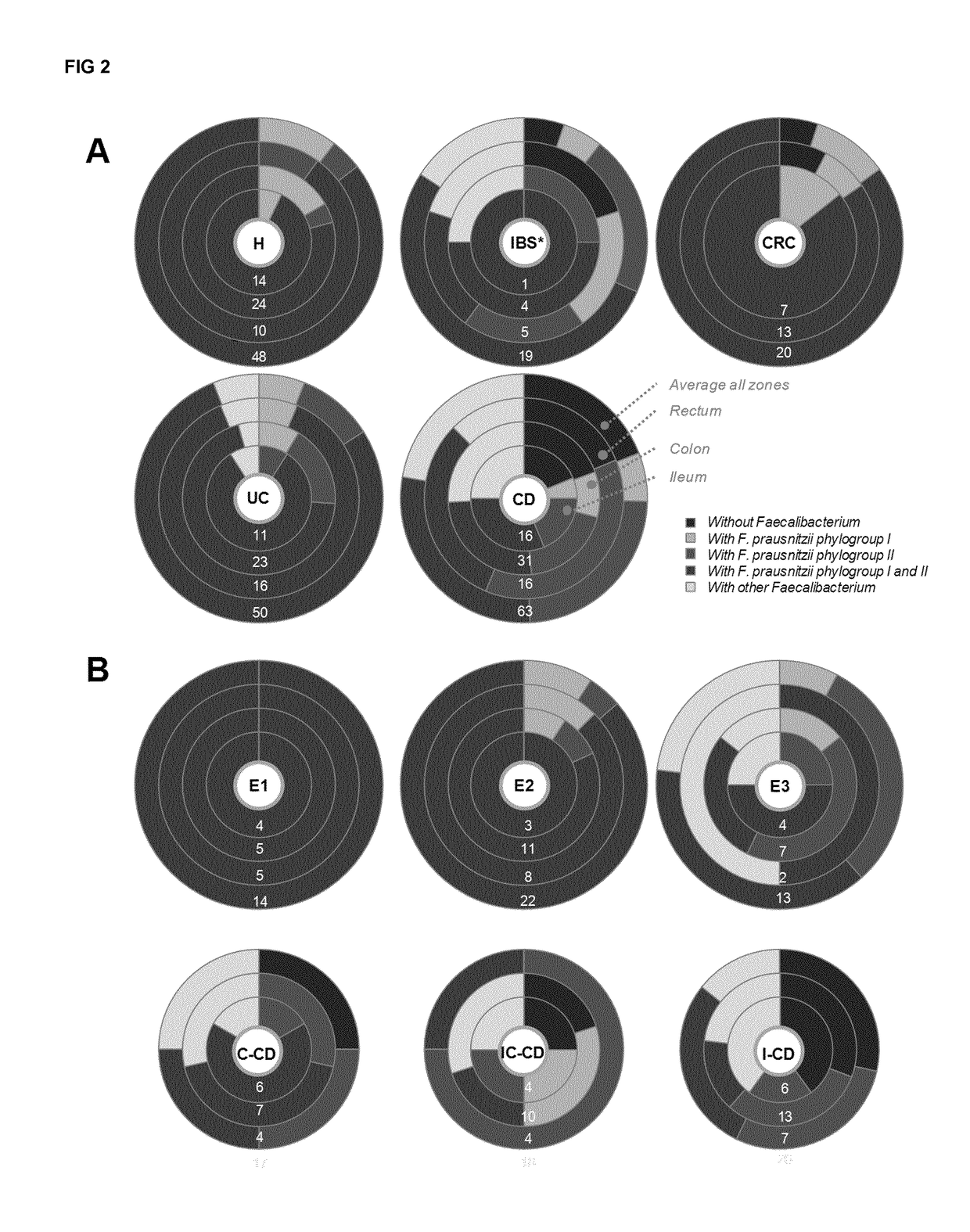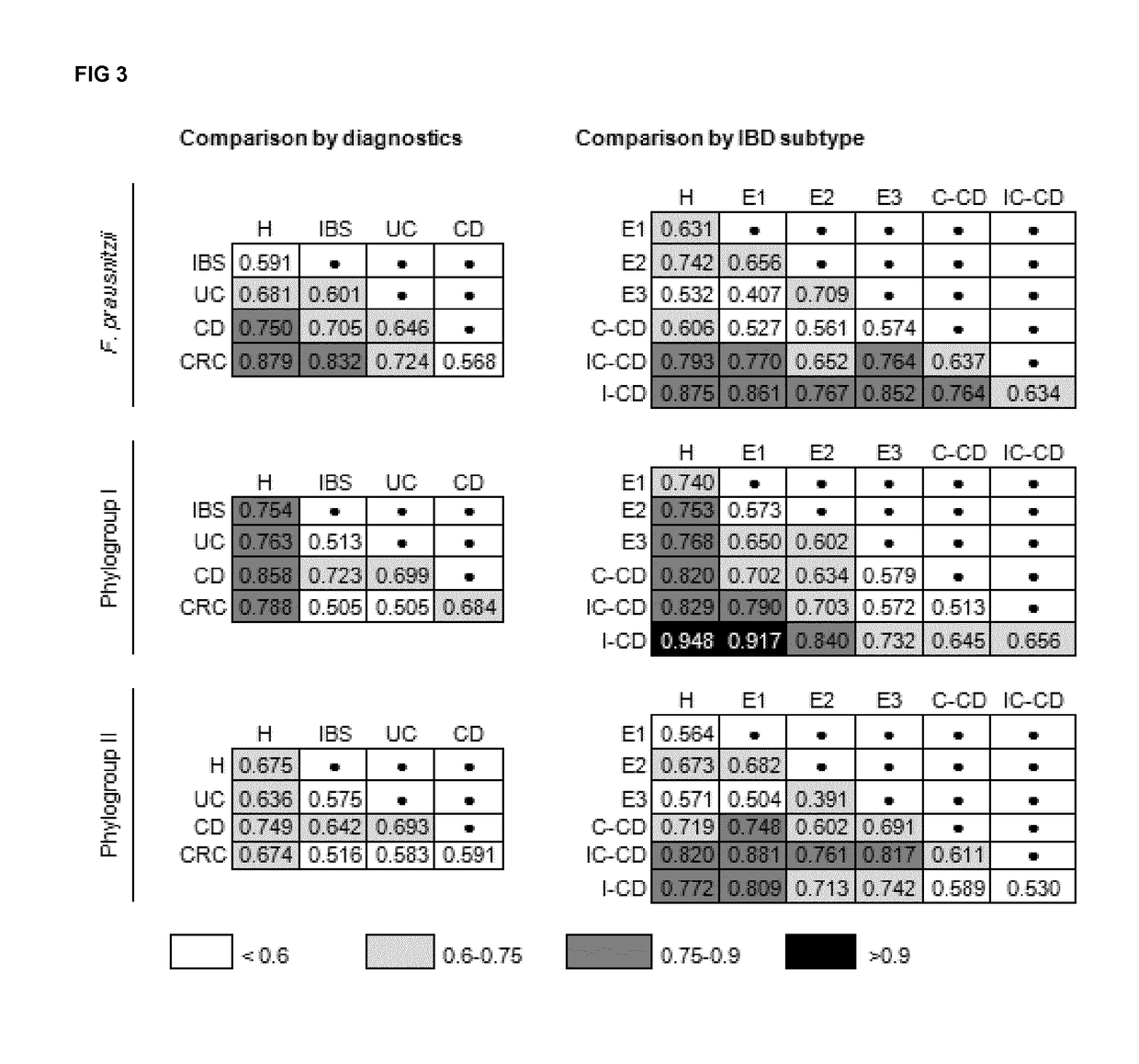Method for the quantification of faecalibacterium prausnitzii phylogroup i and/or phylogroup ii members and the use thereof as biomarkers
- Summary
- Abstract
- Description
- Claims
- Application Information
AI Technical Summary
Benefits of technology
Problems solved by technology
Method used
Image
Examples
example 1
Materials and Methods of F. Prausnitzii Phylogroups
Quantification in Biopsy Samples
1. Patients, Clinical Data and Sampling.
[0525]A Spanish cohort consisting of 70 IBD (45 CD and 25 UC), 10 IBS, 20 CRC patients, and 31 H was enrolled (Table 13).
[0526]Subjects were recruited by the Gastroenterology Services of the Hospital Universitari Dr. Josep Trueta (Girona, Spain) and the Hospital Santa Caterina (Salt, Spain). Subjects were gender matched for all the groups. Concerning age, CD patients were younger than those in the H group (P). The diagnosis of CRC was established by colonoscopy and biopsy, and data correlated with high risk of developing this disease was recorded. The control group consisted of subjects undergoing colonoscopy for different reasons as rectorrhagia (N=9), colorectal cancer familial history (N=11), and abdominal pain (N=11). Clinically relevant data of all the patients was collected. None of the subjects received antimicrobial treatment for at least two months befo...
example 2
Features of the Novel Multiplex qPCR Assay for F. Prausnitzii Phylogroups I and II
[0544]A novel oligonucleotide set was designed to quantify the two recently described F. prausnitzii phylogroups (Table 15). The in silico analysis of the oligonucleotide set of choice showed that primer Fpra 136F-Fpra 232R were specific for F. prausnitzii and targeted all the isolates available to date, whereas the probes PHG1 180PR and PHG2 180PR specifically matched phylogroups I and II, respectively. These results were confirmed in vitro by the inclusivity-exclusivity tests (Table 16). Coverage of the Fpra 136F-Fpra 232R primers set was 74.85% of the sequences in the SILVA datasets. PHG1 180PR probe targeted 20.50% of the Faecalibacterium sp. sequences whereas PHG2 180PR probe coverage was 38.80% of the Faecalibacterium sp. sequences in this database. Approximately 25% of all Faecalibacterium sequences available in SILVA dataset are not targeted in silico by any of these assays. This discrepancy co...
example 3
Prevalence of Mucosa-Associated F. Prausnitzii and Phylogroups I and II Along the Gut in Health and Disease
[0546]Prevalence of F. prausnitzii and both phylogroups as calculated from positive determinations over total samples was analyzed by disease status considering all the data across all sites (FIG. 1). F. prausnitzii prevalence was lower in CD patients than in H (FIG. 1). CD patients with I-CD feature lower F. prausnitzii prevalence than those with E1, E2, E3 and C-CD. Prevalence values ranged from 81-100%, except for I-CD whose value was significantly lower (down to 68%, P≤0.046).
[0547]As far as the phylogroups are concerned, both were found to be less prevalent in CD patients (P<0.001) than in the H and CRC groups, particularly in those with ileal involvement (FIG. 1). For CRC and UC patients, the prevalence remained similar to H. Nevertheless phylogroup I showed a trend of lower values in ulcerative pancolitis, which did not reach statistical significance (P=0.053) probably d...
PUM
| Property | Measurement | Unit |
|---|---|---|
| Fraction | aaaaa | aaaaa |
| Fraction | aaaaa | aaaaa |
| Fraction | aaaaa | aaaaa |
Abstract
Description
Claims
Application Information
 Login to View More
Login to View More - R&D
- Intellectual Property
- Life Sciences
- Materials
- Tech Scout
- Unparalleled Data Quality
- Higher Quality Content
- 60% Fewer Hallucinations
Browse by: Latest US Patents, China's latest patents, Technical Efficacy Thesaurus, Application Domain, Technology Topic, Popular Technical Reports.
© 2025 PatSnap. All rights reserved.Legal|Privacy policy|Modern Slavery Act Transparency Statement|Sitemap|About US| Contact US: help@patsnap.com



